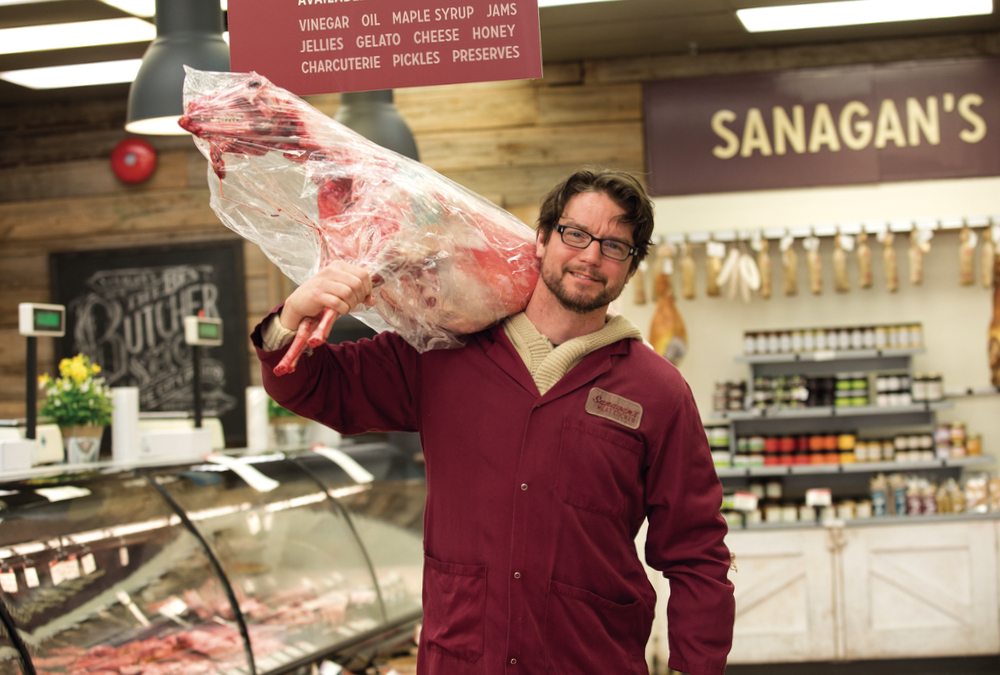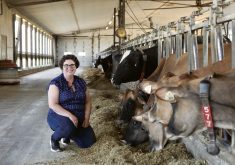A truck pulls up in front of the butcher shop on the narrow, one-way street and parks under a no-stopping sign. Pedestrians emerge from shops and dart from one side of the street to the other. In the air there are smells of coffee, restaurants, even cannabis, and everything is laid out to celebrate food and shopping.
The Kensington Market has deep roots as a busy, exciting spot, although you have to feel for the delivery truck driver.
Good as farmers are with anything mechanical, you also have to ask, why would a producer want to make that driver’s job part of their weekly routine?
Read Also

Riding the tariff rollercoaster
Farmers are accustomed to roller-coaster years. But the current geopolitical windstorm is something else entirely. On his cattle operation near…
It turns out I’m not the only one looking for an answer.
The truck driver hops out and opens the back and some sheep carcasses are carried out of the truck and in through the front door of Sanagan’s Meat Locker. The Country Guide photographer, Anne, points this out to me and mentions that it might be a good photo.
I count five youngish people working the shop, which has a meat counter along one wall, a charcuterie counter along another, and shelves and coolers with specialty and prepared foods in any other free spot. We ask the clerks at the cash register where to find Peter Sanagan, and one of them goes to the back to tell him we are here.
We ask Sanagan if he’d mind grabbing one of the sheep for a photo. The affable Sanagan puts a red coat over his cardigan, heads to the back for a sheep, and returns holding it up for a photo.
Opportunity in a shorter supply chain
When I first call Sanagan’s Meat Locker to connect with Peter Sanagan, the telephone message says, “Thank you for calling Sanagan’s Meat Locker, serving quality meats and poultry from Ontario family farms since 2009.”
“The main philosophy that we have is that we source everything from Ontario family farms,” Sanagan later tells me. Buying directly from farms gives Sanagan unique products for his customers. The buy-direct, Ontario focus goes beyond the meat, including products such as the barbecue sauces.

Having that direct link to the farm also helps Sanagan get to know the story of what he sells. He can talk about the ratio of corn an animal is fed, or the conditions it’s raised in.
“I find that there’s a real kind of tactile enjoyment with food and careers in food,” says Sanagan, talking about how he got into the food business. He has channelled that enjoyment into a unique shopping experience.
The route to Grey County
He was 17 years old when his father was transferred to Hong Kong for work. Sanagan didn’t attend school there — so, to keep busy, he started to cook. “That’s where I got interested” he explains, as he talks about exploring Hong Kong food markets.
His new-found interest in food gave him a focus when he returned to Canada. “When I came back I started knocking on doors and trying to get into restaurants,” he says. He studied to become a chef, working in Toronto, Italy — and then ended up in Grey County, a largely rural and agricultural area a couple of hours northwest of Toronto.
It was in Grey County, working as a chef, that Sanagan first bought meat directly from farmers. “When I was there I started using a lot of the local farmers to supply me with the meat and vegetables,” says Sanagan. He found quality and variety. Yet few of the producers, especially the smaller producers, were selling into the huge, hungry Toronto marketplace that was on their doorstep.
From cooking to a butcher shop
After returning to Toronto to teach courses at George Brown College, Sanagan saw a butcher shop for sale in Toronto’s Kensington Market district. He thought this could be an opportunity for him to supply Torontonians with the meats that had so impressed him when he worked in Grey County.
“I just jumped on it,” says Sanagan as he talks about opening his first butcher shop 10 years ago, just down the street from the present location.
His original store was very small, and when the current location became available, the landlord approached him to see if he would be interested. The larger store gave him space for more charcuterie and prepared foods. The shop has been in the current location for seven years.

The business has continued to grow. “We now have a second location in the east end of town,” says Sanagan. They also supply restaurants and do a lot of prepared foods. “There is a big emphasis on charcuterie,” he says, as he talks about the French-style pâtés. There are 50 employees between the two stores.
Sanagan, who is 43, says that a lot of small neighbourhood butcher shops are family run, often by people nearing retirement age. There is a youthful energy around the store.
Connecting with farms
“All of our farmers are small farmers,” he says as we tour the meat locker. It’s Monday — and there is still space to hang quite a bit more meat behind the sheep that arrived today. Sanagan says that by Friday this room will be full.
Finding suppliers is not a problem. “We’re lucky to be in a part of the world with access to so much amazing product,” says Sanagan as he talks enthusiastically about the different Ontario meats that he sells.
To find supplier-farmers, he initially went back to Grey County, to attend an agri-food symposium. He already knew a couple of key people there from his stint as a chef — and they introduced him to other farmers.
As his business and reputation grew, farmers started to contact him. Sometimes he even meets farmers here in the city; Sanagan shows me a leaflet from a beef farmer he recently met at the Restaurants Canada trade show.
The size of the farms he deals with varies. “We have a variety of farmers we work with, some smaller than others,” he says. His grass-fed beef comes from a small farm that brings him one animal a month. But he gets grain-fed beef from a few different farms. “When you need a bunch of striploins, you’re able to pull from more than one,” he explains.
Working directly with farms
Talking about the pros and cons of working directly with small farms instead of distributors, Sanagan says, “The pro is that the quality is way better.” The main challenge is consistency. “We want the same quality over and over,” he says, giving the example of marbling on beef.
When there is a problem, for example, maybe a batch has been processed poorly, Sanagan says that good communication is important. “We have to make sure they know about those problems right off the hop and we work together to make sure we get a consistently high quality that meets our expectations.”
He says there can be other small challenges to dealing directly with smaller producers — but downplays them. There are always things like delivery challenges, weather-related delays and truck breakdowns. “Some farmers don’t like driving in this neighbourhood,” he says with a laugh.
Retail meat business
“It’s a really expensive business model to have a retail butcher shop,” says Sanagan as he talks about the industry. “You need a ton of people doing customer service.”
Of course, the rent in Toronto is also very high.
But despite the challenges of having a retail location, Sanagan says he hopes to open more locations. Talking about the second store, which is only 900 square feet, he says, “It shows the potential of having these little neighbourhood places.”
It’s important to be located somewhere near where people live, cook — and barbecue. This Kensington Market location works well. But he’s not sure whether farther downtown, amongst all of the new high-rise condominiums, would work as well because a lot of the new condos have very small kitchens and are not conducive to cooking.
On new skills
“It’s been an uphill battle for me,” says Sanagan as he talks about the transition from being a chef to running a butcher shop. He says that although he had an understanding of food and food costs, he had a big learning curve when it came to many of the other skills needed to run a business. He talks about cost controls, leadership skills and human resources. “It’s challenging to stay on top of costs and make sure that we’re making the right business decisions,” he says.
Sanagan feels that outside expertise is important. He brought in a consultant to help build the culture at the store and create a mission statement; and had another consultant help him look at financial statements, to get a better understanding of what needs to be spent, and what doesn’t. He’s currently taking courses on retail management.
Looking ahead
Sanagan is introducing e-commerce. “The delivery component has become a lot easier now,” he says as he talks about delivery options.
But Sanagan does not think that a rise in e-commerce will make retail stores obsolete.
As he talks about customers who could shop online or at grocery store, he says, “A lot of people enjoy the experience of shopping in a store like this.” He has friendly staff, unique products and a wide breadth of products.
It’s the sort of place, he says, where you can come when you aren’t sure what you want to cook. “There are so many options.” The combination of variety and service turns shopping into more than shopping — something he calls “the customer experience.” It’s something, he says, you can’t replicate online.















